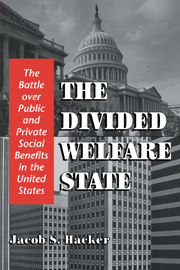Book contents
- Frontmatter
- Contents
- List of Tables
- List of Figures
- Preface
- Part I The American Welfare Regime
- Part II The Politics of Public and Private Pensions
- Part III The Politics of Public and Private Health Insurance
- Introduction
- 4 Seeds of Exceptionalism: Public and Private Health Insurance Before 1945
- 5 The Elusive Cure: Public and Private Health Insurance After 1945
- Part IV The Formation and Future of the American Welfare Regime
- Appendix
- Notes
- Index
5 - The Elusive Cure: Public and Private Health Insurance After 1945
Published online by Cambridge University Press: 05 June 2012
- Frontmatter
- Contents
- List of Tables
- List of Figures
- Preface
- Part I The American Welfare Regime
- Part II The Politics of Public and Private Pensions
- Part III The Politics of Public and Private Health Insurance
- Introduction
- 4 Seeds of Exceptionalism: Public and Private Health Insurance Before 1945
- 5 The Elusive Cure: Public and Private Health Insurance After 1945
- Part IV The Formation and Future of the American Welfare Regime
- Appendix
- Notes
- Index
Summary
The United States emerged from World War II with a growing economy, a strengthened state, and a mobilized national community. It emerged, too, as the undisputed economic and military leader of the Western world. Many on the left believed America's new global responsibilities would unify Americans in support of expanded government programs, much as the Great Depression had before. The war itself led to the passage of government health programs for military personnel and their dependents, and preinduction physicals revealed that a large proportion of young men were not fit for service, raising new concerns about the nation's health. Perhaps most important, public support for national health insurance rose during the war, with the share of Americans expressing support for a health program similar to Social Security reaching 85 percent in 1943.
Yet hopes for national health insurance went unfulfilled, both immediately after the war and in the decades that followed. World War II did not lead to a major new program of government insurance or provision as it did in Britain, nor was it followed by the subnational policy experiments of the sort that bubbled back up into Canadian federal policy. Like Civil War pensions and War Risk Insurance, the special programs extended to soldiers and their families proved to be fleeting experiments or remained the guardians of veterans alone. A quixotic postwar crusade by President Truman to enact national health insurance ended with the repudiation first of his goal and then of his party's presidential candidate.
- Type
- Chapter
- Information
- The Divided Welfare StateThe Battle over Public and Private Social Benefits in the United States, pp. 221 - 270Publisher: Cambridge University PressPrint publication year: 2002
- 1
- Cited by

